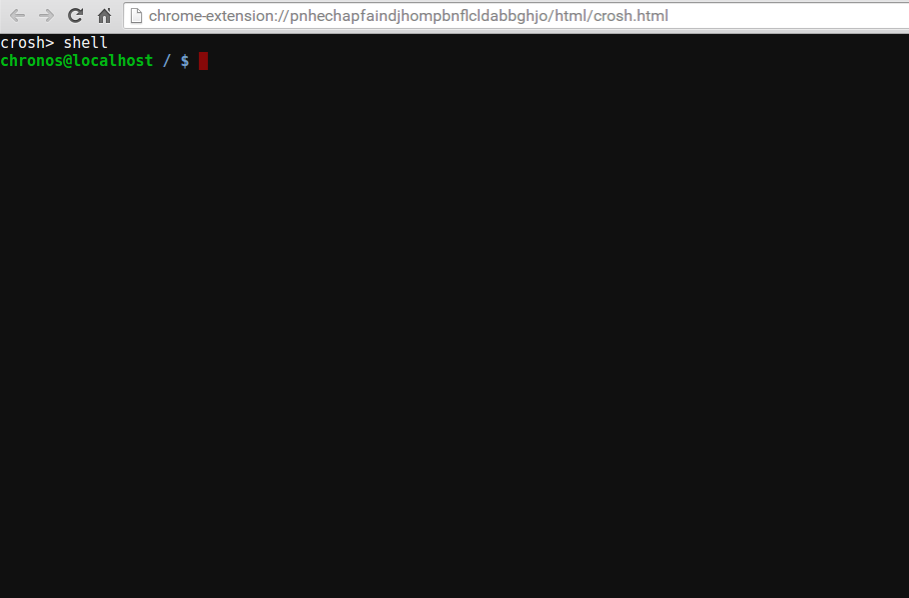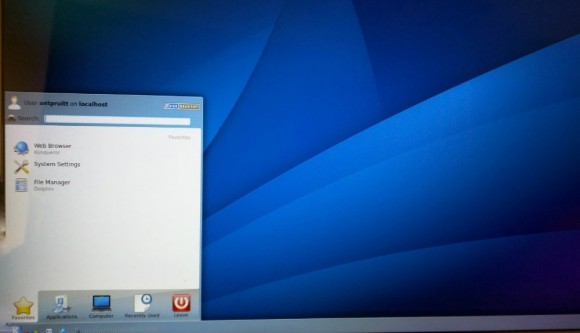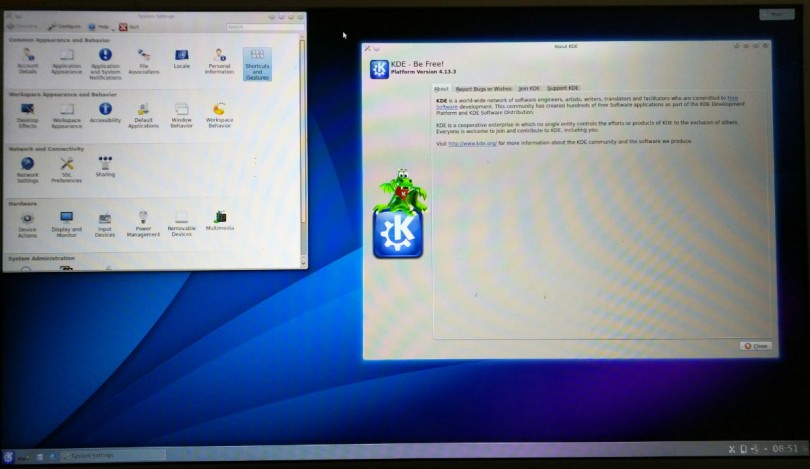aNewDomain  — My Acer C710 Chromebook’s has been a very cool tool for me and my family over the last year. I never have to worry about malware or being the tech support guide. And it’s easy. Anyone can just pick it up cold and start checking email, manage social media and surf the web. With ChromeOS, all you really need to know is how to use a web browser.
— My Acer C710 Chromebook’s has been a very cool tool for me and my family over the last year. I never have to worry about malware or being the tech support guide. And it’s easy. Anyone can just pick it up cold and start checking email, manage social media and surf the web. With ChromeOS, all you really need to know is how to use a web browser.
But sometimes, I want to do more with the Chromebook, things that the Chromebook won’t support. What I needed was more software support, and I was constrained by the list of Chrome OS apps. That’s why I started to explor Crouton.
Crouton is an open sourced project that lets Chromebook owners to boot into Ubuntu Linux and ChromeOS simulatneously. To do this, it takes advantage of the Linux fundamentals built into the ChromeOS. It’s a brilliant idea, really. Crouton makes it so a geek like me can buy a cheap laptop for under $300, run a built-in OS that’s capable of doing more daily tasks but also access Ubuntu for running geeky hacks from the command line.
We geeks do like the command line.
But I was disappointed the first time around with Crouton. I was miserably disappointed with it when I installed it last year. It was slow and buggy. Crouton caused intermittent hardware failure. My WiFi NIC wouldn’t even work with it. So I ditched it.
Things change. I gave Crouton another chance recently and now I love it. The hardware and performance issues are gone..Here’s how to install Crouton on a Chromebook.
How To Install Crouton
Before you begin, back up your Chromebook data. Just head to your Downloads folder and make sure you back up everything you don’t want to lose.
After you’ve backed up your data, create a recovery USB stick just in case all things go to heck when installing Linux.
Now put your Chromebook into Developer Mode. This will let you easily get into your Chromebook’s root file system. To get into Developer Mode, hit the ESC+REFRESH+POWER buttons.

You’ll get a scary warning that the OS isn’t verifiable. Ignore it.
Hit CTRL-D to make your Chromebook continue into Developer Mode. Try to be patient. This process could may take up to 10 minutes to complete.
When it’s done, your Chromebook will reboot and then return you to the OS warning screen. When you see it, press CTRL-D again to log in as usual.
Now for the nitty gritty. It’s time to download the zip file from the Crouton project page. Here it is. Time to get your command line geek on!
Now open up the Chromebook terminal by pressing CTRL-ALT-T. The terminal will open up in a new tab with the cursor at the “crosh” prompt. Now get your Chromebook into the actual shell software. To do this, type: shell
Hit enter.

Now you’ll begin the installation command. Before you install, know that you have options regarding your Linux installation. The distro will be a version of Ubuntu with options on the desktop environments available.
“What the heck are you talking about when you say desktop environments, Ant?” All I’m talking about the look and feel of your installation. But if all this really confuses you, check out this nice description of common desktop environments. Decide on the one you like best.
Type in the specified command. Right now, I’m selecting Ubuntu Linux version 14.04 (Trusty) and KDE desktop version.
Type: sudo sh ~/Downloads/crouton -r trusty -t kde
Press ENTER.

Note: If you’re curious about installing older versions of Ubuntu, it’s easy to check their compatibility with Crouton. Just enter the following at the command line: sudo sh ~/Downloads/crouton -r list
The Crouton installation will take roughly 15 minutes.

Once the install is complete, the system will prompt you to create a username and password. Do so and press enter.
Now the installation will land you back a the terminal tab where you’ll confirm the installation. To that, type: sudo enter-chroot and hit enter.
Now that you’re inside the shell, type sudo start(your desktop environment here) and press enter. For instance my desktop environment is KDE, so my command is sudo startkde.
This will put you into the Ubuntu Linux partition created by Crouton.You will see it is absolutely beautiful.

Here you can do whatever you’d like to do in the world of Linux to your heart’s content. Check out the multitude of Ubuntu apps out there for productivity, multimedia consumption, editing and more.
You’ll also want to take a look at the web browser to check your social media.
When you’re done, power off your new Crouton Chromebook by choosing Shutdown.
Before you go, I do recommend running the system update after the first install just to make sure there’s nothing new available for your distro. Return to the terminal and type the following command: sudo apt-get update
Hit ENTER.
How To Switch Between Linux and ChromeOS
Every time you boot your Crouton Chromebook, you’ll still boot into ChromeOS — by default. This lets you access your data and Chrome apps like you did before. But you can set things up to dual boot and simultaneously run ChromeOS and your installed Linux distribution.
To do this log into the Linux distro from the terminal by hitting CTRL-ALT-T. Enter your start command reflecting your Linux distro (mine is startkde) at the prompt.
When you’re in Linux, you can toggle back to ChromeOS on the fly without logging out. Just press CTRL-ALT-SHIFT-LEFTARROW
Now your Linux session will still run in the background when you toggle to ChromeOS. And vice versa.
How To Get Rid of Your Linux Partition
If you decide to part ways with the Linux partition, you can totally uninstall it. There are two ways to this.
You can do a complete Chromebook recovery using the recovery USB you created before installation. This will wipe the SSD clean and give you a totally fresh install.
Or, you can run the uninstall command to get rid of Crouton. Head to the prompt and enter: sudo edit-chroot -d trusty
This will remove the user “chroot,” which is what the Linux distro is running under, under the Ubuntu distro, Trusty.
Final Thoughts
This 2015 version of Crouton is somuch better than the 2014 version. I’ve seen typical smooth performance regardless of the environment. I do highly suggest checking for updates after your installation.
I also suggest installing the “restricted extras” in Ubuntu. This package includes multimedia codecs and apps commonly used. Just enter the command: sudo apt-get install ubuntu-restricted-extras
My only concern about Crouton has to do with the QWERTY keyboard that comes with Chromebooks. They are not quite the same as keyboards you get with a Windows PC. This can be a problem. Linux uses a lot of function key shortcuts, just like Windows does. But Chromebooks don’t have “F” keys labeled on the top row.
Also, in the Chromebook and on my ChromeOS partition, my CAPSLOCK key is the native search key. While inside of the Linux partition, I have to press ALT+SEARCH to get the CAPSLOCK. This is a nuisance for someone like me, because I enjoy writing and using lots of acronyms that requre CAPS.
With those nits aside, I still find Crouton on the Chromebook a great option for more geeky users looking to get a little more out of the inexpensive Chromebook. It serves as an easy way for Chromebook-carrying developers to get their IDE installed. IDE, short for Integrated Developer Environment, is software that is required for writing code to build apps.
I look forward to spending more time with my trusty Chromebook. Watch my columns here at aNewDomain for more Chromebook tips and tricks as well as Crouton news, as it becomes available.
I am Ant Pruitt and this is aNewDomain.














Thank you for this very informative guide, Very well put. I am looking into buying my first chromebook & deciding to go with the Acer chromebook 15, only thing is I can’t decide on which processor Celeron, i3, i5.. Will the Celeron (4gb RAM 32gb Storage) have enough power to run Ubuntu Trusty/KDE? The Celeron is on sale right now & cost around $170 less than the core i5 so very tempting, but at the same time if the core i5 is worth it I wouldn’t mind spending the extra $. I really like the way Unity desktop version looks but would it be too much for a chromebook for example the i5 processor? The main thing I want is to have a smooth experience with Ubuntu via Crouton with no problems! But also overall a very speedy, snappy, fast chromebook. Sorry for the lack of my knowledge but I am very new to all this & I haven’t had luck getting any help/advice.. What do you suggest?